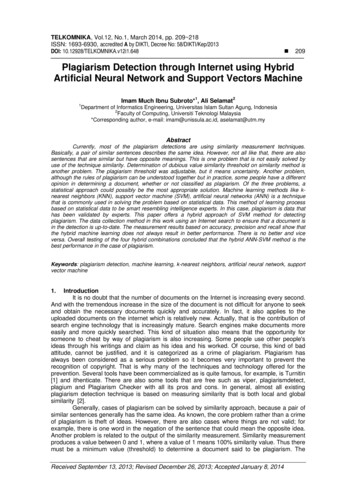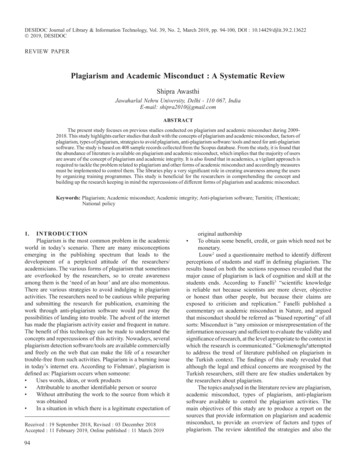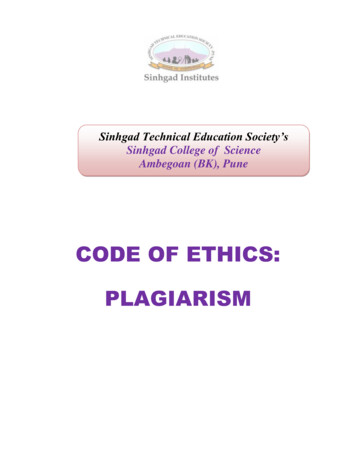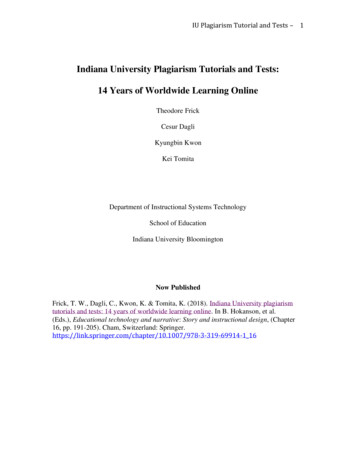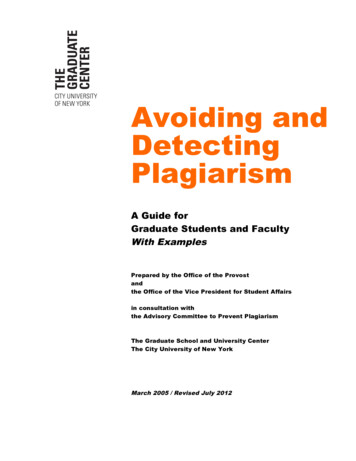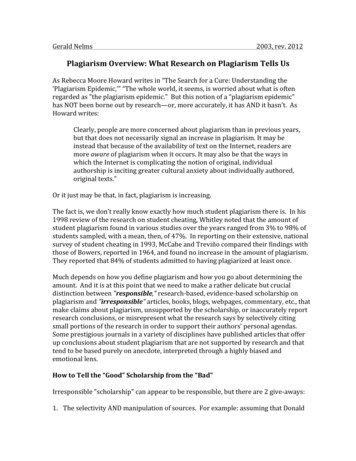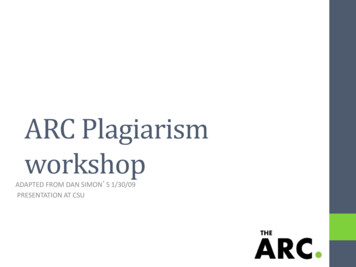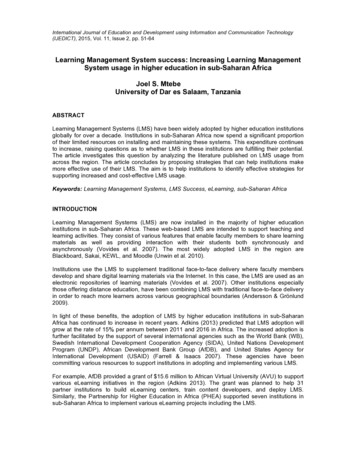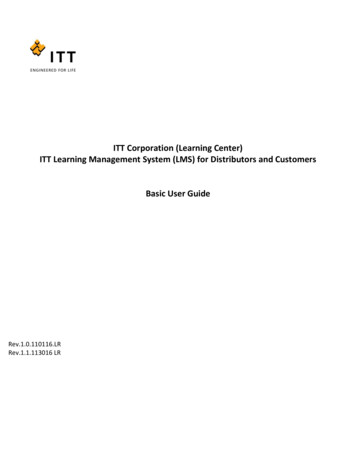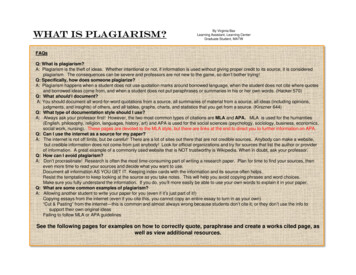
Transcription
What is plagiarism?By Virginia BaxLearning Assistant, Learning CenterGraduate Student, MATWFAQsQ: What is plagiarism?A: Plagiarism is the theft of ideas. Whether intentional or not, if information is used without giving proper credit to its source, it is consideredplagiarism. The consequences can be severe and professors are not new to the game, so don’t bother trying!Q: Specifically, how does someone plagiarize?A: Plagiarism happens when a student does not use quotation marks around borrowed language, when the student does not cite where quotesand borrowed ideas come from, and when a student does not put paraphrases or summaries in his or her own words. (Hacker 570)Q: What should I document?A: You should document all word-for-word quotations from a source, all summaries of material from a source, all ideas (including opinions,judgments, and insights) of others, and all tables, graphs, charts, and statistics that you get from a source. (Kirszner 644)Q: What type of documentation style should I use?A: Always ask your professor first! However, the two most common types of citations are MLA and APA. MLA is used for the humanities(English, philosophy, religion, languages, history, art) and APA is used for the social sciences (psychology, sociology, business, economics,social work, nursing). These pages are devoted to the MLA style, but there are links at the end to direct you to further information on APA.Q: Can I use the internet as a source for my paper?A: The internet is not off limits, but be careful! There are a lot of sites out there that are not credible sources. Anybody can make a website,but credible information does not come from just anybody! Look for official organizations and try for sources that list the author or providerof information. A great example of a commonly used website that is NOT trustworthy is Wikipedia. When in doubt, ask your professor.Q: How can I avoid plagiarism?A: Don’t procrastinate! Research is often the most time-consuming part of writing a research paper. Plan for time to find your sources, theneven more time to read your sources and decide what you want to use.Document all information AS YOU GET IT. Keeping index cards with the information and its source often helps.Resist the temptation to keep looking at the source as you take notes. This will help you avoid copying phrases and word choices.Make sure you fully understand the information. If you do, you’ll more easily be able to use your own words to explain it in your paper.Q: What are some common examples of plagiarism?A: Allowing another student to write your paper for you (even if it’s just part of it!)Copying essays from the internet (even if you cite this, you cannot copy an entire essay to turn in as your own)“Cut & Pasting” from the internet—this is common and almost always wrong because students don’t cite it, or they don’t use the info tosupport their own original ideasFailing to follow MLA or APA guidelinesSee the following pages for examples on how to correctly quote, paraphrase and create a works cited page, aswell as view additional resources.
How to QuoteOriginal Source #1:Jensen, Eric. Student Success Secrets. Hauppauge. Barron’s. 1996 You’ve seen others with thatpersonality magic or some kindof charisma. How do theydevelop it? It’s not hard,but it does take time. Why?Everything you think has thepossibility of leading to anaction. Every action you takecan lead to habit. Every habityou develop becomes yourpersonality and a winning (orlosing) attitude. So, it’s15easy to see that PLAGIARIZED Student Examples:#1Eric Jensen believes that everything you think has the possibility of leading to an action.Every action you take can lead to habit. Every habit you develop becomes yourpersonality and a winning (or losing) attitude. When studying for #2Many women remain inactive, despite the fact that “research has shown definite health benefits forwomen—including a lower risk of osteoporosis, certain cancers, and heart disease. “ Theseproblems Why these are wrong:#1This student did not use any quotation marks. By doing this, it appears that the quoteis actually the student’s words. The student also did not cite the source. Even thoughthe student gives mention to the author, this is still plagiarism.#2This student remembered to use quotation marks, but she did not cite the source.15Original Source #2:CORRECT Student ExamplesHales, Diane. An Invitation to Health, 7th Ed. Pacific Grove: Brooks, 1997.#1Eric Jensen believes, “Everything you think has the possibility of leading to anaction. Every action you take can lead to habit. Every habit you developbecomes your personality and a winning (or losing) attitude.” (15) With thesewords of advice #2Though it is common knowledge that exercise has numerous health benefits,“approximately 70% of women are sedentary or irregularly active.” (Hales 123)Why these are correct:#1This student correctly used quotation marks to begin and end theborrowed sentence. Immediately after the quote, she puts the correctpage number that the quote came from. In this instance, the author’sname does not need to be included in the citation because it is usedto introduce the quote.123#2This student also correctly used quotation marks around the borrowed sentenceand immediately cited its source. In this example, the name of the author wasincluded in the citation because the author was not mentioned.
How to ParaphraseOriginal Source#3:Nash, Gary, et al. The American People: Creating a Nationand Society. 2nd ed. Vol. 2. New York: Harper, 1996.PLAGIARIZED Student Examples:#3Even though two-thirds of the states passed child labor laws between 1905 and 1907, a largenumber of children were still exempt, especially newsboys and youngsters in theater.(Nash458)#4After a ban on killing humpbacks was initiated in the 1960s, these whales began to flourish in theNorth Pacific, skyrocketing their numbers from just a few thousand forty years ago, to possibly tenthousand or more today.Why these are wrong:#3This example uses far too many phrases that are word-for-word identical to the original. Evenreplacing many of those words with synonyms would still make it plagiarism because the structureis just too similar.Original Source #4:#4This example of paraphrasing is actually a good one, but the student failed to cite where thesource came from. Regardless of his use of original wording, it is still plagiarism.Chadwick, Douglas. “What Are They Doing Down There?” NationalGeographic Jan. 2007: 72-93.CORRECT Student Examples#3According to Gary Nash, in the early twentieth century, two-thirds of the states passed laws thatprohibited child labor in some way, however, many of these were flawed and did not protect allchildren. (458)#4Humpback whales have seen a dramatic turn-around since the 1960s when a ban was placedon killing the few thousand that were left. Since then, SPLASH, the largest whale-census evercarried out, predicts that in the North Pacific the whales have prospered to ten thousand ormore. (Chadwick76)Why these are correct:#3This example introduces the author as well as summarizes the information in anoriginal way. At the end of the paraphrase, the student cited the page number, butremembered the name was not necessary, since she already mentioned the author’sname.#4This example is correct because it also summarizes the information in an original way and thestudent correctly cited its source. Because the author’s name was not mentioned in theparaphrase, he included it in the citation.
How to Create a Works Cited Page A Works Cited page is the LAST page of your½ in1”paper and it is numbered just like the rest of thepages, in the upper right hand corner.Works Cited Use 1” margins Space your name and page number ½” from thetopDouble-space betweentitle and first entry1”Chadwick, Douglas. “What Are They Doing Down Double space from the title (Works Cited) toyour first entryThere?” National Geographic Jan. 2007: 72½ in93. Indent ½” any additional lines after the first ineach entrySmith 12Hales, Diane. An Invitation to Health, 7th Ed. Double space within each entry and betweenPacific Grove: Brooks, 1997.them Alphabetize each entry by author’s last name (orJensen, Eric. Student Success Secrets. City.Publisher. 1996if there is no author, the first word of the title) You MUST include ALL sources you cited,Nash, Gary, et al. The American People: Creatingreferenced or paraphrased Reference the MLA Handbook for Writers ofResearch Papers by Joseph Gibaldi for moredetailed information concerning your sourcesand how to document thema Nation and Society. 2nd ed. Vol. 2. NewDouble-spaceYork: Harper, 1996. Remember that every kind of source, whether abook, magazine, internet source or audio tape,has its own special citation. You can learn how tocite pretty much every kind of source through theMLA Handbook.Gibaldi 1461”
SourcesFORMORE HELPPEOPLE & PLACES:Your Professor: Your professor wants you to ask questions! He or she will be happy to help you get it right.Learning Center, House 71 (library circle): A great place for all kinds of academic help, tutoring andreferences.HSU Library: All kinds of references about plagiarism can be found in the library. If you need helping finding them, ask a librarian.HSU Writing Center, FH 201: For help with specific papers, this is an excellent place to go.SPECIFIC BOOKS:MLA Handbook for Writers of Research Papers, by Joseph Gibaldi—this can be found in the HSU library, the Learning Centerand your professor may even have his or her own copy.Mastering APA Style: Student’s Workbook and Training Guide, by Harold Gelfand—this can be found in the HSU library,along with numerous other APA style guidebooks.ON-LINE SOURCES:Avoiding Plagiarism-Online Writing Lab at rch/r plagiar.htmlPlagiarism: What it is and How to Recognize and Avoid It-Writing Center, Indiana University, Bloomingtonhttp://www.indiana.edu/ wts/pamphlets/plagiarism.shtmlHow Not to Plagiarize-Margaret Proctor, Coordinator of Writing Support at the University of Plagiarism Quiz: What is Plagiarism (at Indiana University)?http://education.indiana.edu/ frick/plagiarism/item1.htmlCitation Machine – an easy tool for formatting your citations for several different styleshttp://citationmachine.netAPAAPA formattinghttp://citationmachine.netAPA Style.orghttp://www.apastyle.org/APA Citation citapa.htmOnline Writing Lab at Purduehttp://owl.english.purdue.edu/
Works CitedChadwick, Douglas. “What Are They Doing Down There?” National Geographic Jan.2007: 72-93Gibaldi, Joseph. MLA Handbook for Writers of Research Papers. 6th ed. New York: MLA, 2003Hacker, Diana. The Bedford Handbook 5th ed. Boston: Bedford Books, 1998Hales, Diane. An Invitation to Health 7th ed. Pacific Grove: Brooks, 1997Jensen, Eric. Student Success Secrets. Hauppauge: Barron’s, 1996Kirszner, Laurie, and Mandell, Stephen. Focus on Writing: Paragraphs and Essays. Boston: Bedford, 2008Nash, Gary, et al. The American People: Creating a Nation and Society. 2nd ed. Vol. 2 New York: Harper, 1996.
What is plagiarism? FAQs . Q: What is plagiarism? A: Plagiarism is the theft of ideas. Whether intentional or not, if information is used without giving proper credit to its so urce, it is considered . plagiarism. The consequences can be severe and profe ssors are not new to the game, so d

